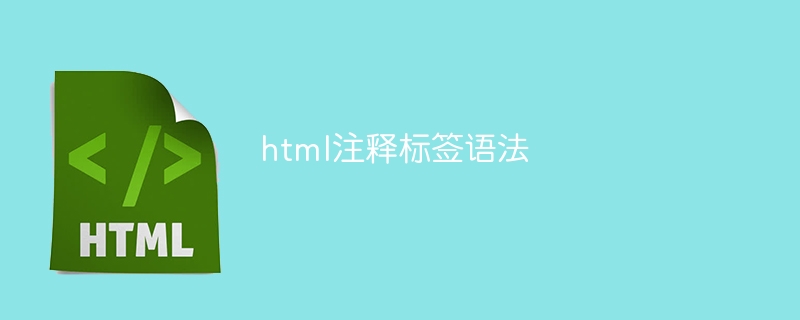Syntax rules for HTML comment tags

HTML comment tag syntax and specific code examples
HTML comment tag is a special tag used to add comments in HTML code to help developers understand and maintain code. In this article, we will detail the syntax of HTML comment tags and provide specific code examples.
The syntax of the HTML comment tag is as follows:
<!-- 这里是注释 -->
<!--is the start tag of the comment,-->Is the end tag of the comment. The middle part is the content of the annotation.- The comment content can be any text, it can be the developer's explanation, remarks or explanation of the code.
Here are some specific code examples to help you understand the usage of comment tags.
Add comments in HTML tags:
<h1 id="这是一个标题">这是一个标题</h1> <!-- 这是一个注释,用于解释上面的标题 --> <p>这是一个段落。</p>
Copy after loginAdd comments in CSS code:
<style> /* 这是一个CSS样式的注释 */ p { font-size: 16px; color: #333; } </style>Copy after loginAdd comments in JavaScript code:
<script> // 这是一个JavaScript注释,用于解释下面的代码 var name = "John"; console.log("Hello, " + name); </script>Copy after loginAdd comments in HTML templates:
<!DOCTYPE html> <html> <head> <title>这是一个网页</title> </head> <body> <h1 id="欢迎来到我的网页">欢迎来到我的网页!</h1> <!-- 以下是网页主要内容 --> <p>这是一个段落。</p> <!-- 网页主要内容结束 --> </body> </html>
Copy after loginPlease note that HTML comment tags will not Whatever content is displayed in the browser, they are only used for communication between developers and illustrations of the code. When the browser parses the HTML code, the comment portion is ignored. Therefore, you can safely use comment tags in code blocks that need to be explained or hidden.
Summary:
By using HTML comment tags, we can add comments in HTML, CSS and JavaScript code to improve the readability and maintainability of the code. Whether you're explaining code, adding notes, or hiding temporary code, comment tags are a very useful tool. I hope the syntax description and specific code examples in this article can help you better understand and use HTML comment tags.The above is the detailed content of Syntax rules for HTML comment tags. For more information, please follow other related articles on the PHP Chinese website!

Hot AI Tools

Undresser.AI Undress
AI-powered app for creating realistic nude photos

AI Clothes Remover
Online AI tool for removing clothes from photos.

Undress AI Tool
Undress images for free

Clothoff.io
AI clothes remover

AI Hentai Generator
Generate AI Hentai for free.

Hot Article

Hot Tools

Notepad++7.3.1
Easy-to-use and free code editor

SublimeText3 Chinese version
Chinese version, very easy to use

Zend Studio 13.0.1
Powerful PHP integrated development environment

Dreamweaver CS6
Visual web development tools

SublimeText3 Mac version
God-level code editing software (SublimeText3)

Hot Topics
 1386
1386
 52
52
 What is the purpose of the <progress> element?
Mar 21, 2025 pm 12:34 PM
What is the purpose of the <progress> element?
Mar 21, 2025 pm 12:34 PM
The article discusses the HTML <progress> element, its purpose, styling, and differences from the <meter> element. The main focus is on using <progress> for task completion and <meter> for stati
 Is HTML easy to learn for beginners?
Apr 07, 2025 am 12:11 AM
Is HTML easy to learn for beginners?
Apr 07, 2025 am 12:11 AM
HTML is suitable for beginners because it is simple and easy to learn and can quickly see results. 1) The learning curve of HTML is smooth and easy to get started. 2) Just master the basic tags to start creating web pages. 3) High flexibility and can be used in combination with CSS and JavaScript. 4) Rich learning resources and modern tools support the learning process.
 What is the purpose of the <datalist> element?
Mar 21, 2025 pm 12:33 PM
What is the purpose of the <datalist> element?
Mar 21, 2025 pm 12:33 PM
The article discusses the HTML <datalist> element, which enhances forms by providing autocomplete suggestions, improving user experience and reducing errors.Character count: 159
 What is the purpose of the <meter> element?
Mar 21, 2025 pm 12:35 PM
What is the purpose of the <meter> element?
Mar 21, 2025 pm 12:35 PM
The article discusses the HTML <meter> element, used for displaying scalar or fractional values within a range, and its common applications in web development. It differentiates <meter> from <progress> and ex
 What is the viewport meta tag? Why is it important for responsive design?
Mar 20, 2025 pm 05:56 PM
What is the viewport meta tag? Why is it important for responsive design?
Mar 20, 2025 pm 05:56 PM
The article discusses the viewport meta tag, essential for responsive web design on mobile devices. It explains how proper use ensures optimal content scaling and user interaction, while misuse can lead to design and accessibility issues.
 What is the purpose of the <iframe> tag? What are the security considerations when using it?
Mar 20, 2025 pm 06:05 PM
What is the purpose of the <iframe> tag? What are the security considerations when using it?
Mar 20, 2025 pm 06:05 PM
The article discusses the <iframe> tag's purpose in embedding external content into webpages, its common uses, security risks, and alternatives like object tags and APIs.
 The Roles of HTML, CSS, and JavaScript: Core Responsibilities
Apr 08, 2025 pm 07:05 PM
The Roles of HTML, CSS, and JavaScript: Core Responsibilities
Apr 08, 2025 pm 07:05 PM
HTML defines the web structure, CSS is responsible for style and layout, and JavaScript gives dynamic interaction. The three perform their duties in web development and jointly build a colorful website.
 What is an example of a starting tag in HTML?
Apr 06, 2025 am 12:04 AM
What is an example of a starting tag in HTML?
Apr 06, 2025 am 12:04 AM
AnexampleofastartingtaginHTMLis,whichbeginsaparagraph.StartingtagsareessentialinHTMLastheyinitiateelements,definetheirtypes,andarecrucialforstructuringwebpagesandconstructingtheDOM.




